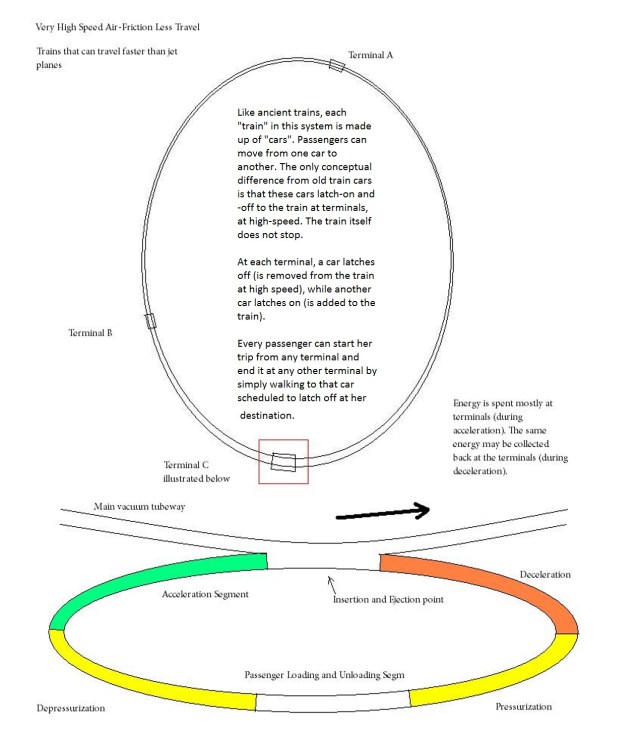Travelling in a semi-vacuum tube offers two very significant advantages:
- speed that is several multiples of jet-plane speed, and
- low energy required per kilometer travelled, per kilogram of transported mass.
However, the HyperLoop as currently envisioned does not take advantage of another source of potential savings in energy: namely, by travelling non-stop. All else being equal, as much as 90% of energy can be saved per trip by not stopping, and this benefit is free, thanks to the law of conservation of kinetic energy. How can passengers get aboard and get off the HyperLoop modules that do not stop? Here is a scheme.
Allow terminals along the reduced-air or vacuum tube track. The tube track itself is a closed loop in which a number of trains travel non-stop. Each terminal along this closed loop is designed to allow a car to be added and removed from the train, while the train is running at high-speed. In between terminals, passengers are free to move from one car to another, just as in normal (“ancient”) trains. This allows every passenger to start her trip from any terminal and end her trip at any terminal (including the one she started from). To end your trip, simply walk to the car that is to be ejected at the next terminal.
The above diagram shows how a car can possibly latch-on and -off the train. Each terminal is a car insertion and ejection point. The bottom of the diagram details how a terminal allows the insertion car to be accelerated up to train speed, and how the ejection car can be decelerated to zero speed (stop). Because the train is travelling at high speed, the insertion/ejection segment should be long enough to give time for a car to insert and another car to get off the train. (The diagram is not drawn to scale, so the length of the insertion/ejection segment is not obvious.)
Each terminal forms a much smaller loop in itself. This smaller loop is divided into segments, color coded in the diagram. The white segment at the bottom is where the insertion car starts and the ejection car stops. The yellow segment to the left is where the insertion car enters through an airtight door. As soon as this airtight door closes, air is pumped out from this chamber while inside the car normal barometric air pressure is maintained. When enough air has been pumped out and air pressure is low enough in the depressurization segment to match that in the main tube track, another airtight door is opened. (This door separates the yellow segment from the green acceleration segment.) In the green segment, the insertion car accelerates until its speed equals the constant train speed. The whole sequence of passenger boarding, depressurization, and acceleration is timed such that, at the same time that the car enters the insertion/ejection segment, the train arrives and is running parallel to it.
At the same time that the insertion car latches itself onto the train, another car forward it is removed from the train. This car slows down as it enters the orange deceleration segment. The yellow segment to the right is already depressurized by the time the ejection car enters it. An airtight door closes behind the car as it enters the yellow pressurization segment. As the car continues to decelerate, the yellow segment is filled with air. By the time it reaches the other airtight door ahead of it, pressure in the yellow segment will have equaled one atmosphere. Passengers can then get off in the passenger unloading segment.
Would you believe I drew the above diagram in April, 2009? I have been thinking about air-friction-free transportation before Elon Musk first published the idea.

